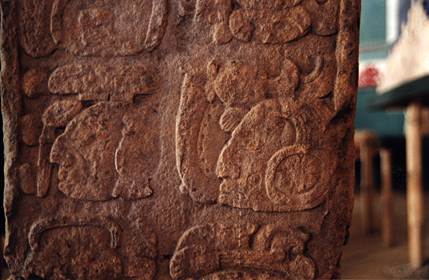

| Possible El Peru emblem glyph (right) in museum at Tonina. Photo:Joel Skidmore. |
![]()
|
May 5, 2004. Archaeologist Hector Escobedo, co-director of the Waka' Archaeological Project, today announced the discovery of Maya queen's tomb at El Peru, Guatemala.
The burial was actually unearthed last February by Southern Methodist University graduate student David Lee, a former private investigator from Toronto. Lee had been digging a trench when his foot broke through the roof of the crypt in a palace structure off one of El Peru's main plazas. The skeleton was found on a stone platform surrounded by ceramic vessels and artifacts of jade, shell, pearl and obsidian. The female's status was inferred from a number of signs, including a jade huunal jewel of the sort worn in royal headdresses. The tomb is said to date to between A.D. 650 and 750. El Peru, known anciently as Waka', was a signficant polity during the Classic period. It is known to have been defeated by Tikal in 743. Analysis of the skeleton revealed that the queen was between thirty and forty-five years old when she died. The tomb's discoverer told the Dallas Morning News that the body had been laid out on a platform of some perishable material built on top of a somewhat smaller platform of stone. A royal burial beneath a palace rather than a pyramid is unusual for the Maya. "The is more of a non-elite pattern, in which the dead lie under the feet of the living," according to Stephen Houston, an archaeologist currently working at Piedras Negras in Guatemala. "This tomb will help us understand how women shared power with men in ruling their kingdoms," said Waka' Project co-director David Freidel of SMU. "Tombs of important royal women have been discovered at fewer than a dozen other sites, including at Palenque and Yaxuna in Mexico; Tikal in Guatemala; and Copan in Honduras." In "Bearers of War and Creation" (online), Freidel and Waka' Project epigrapher Stanley Guenter offer this perspective:
|
home